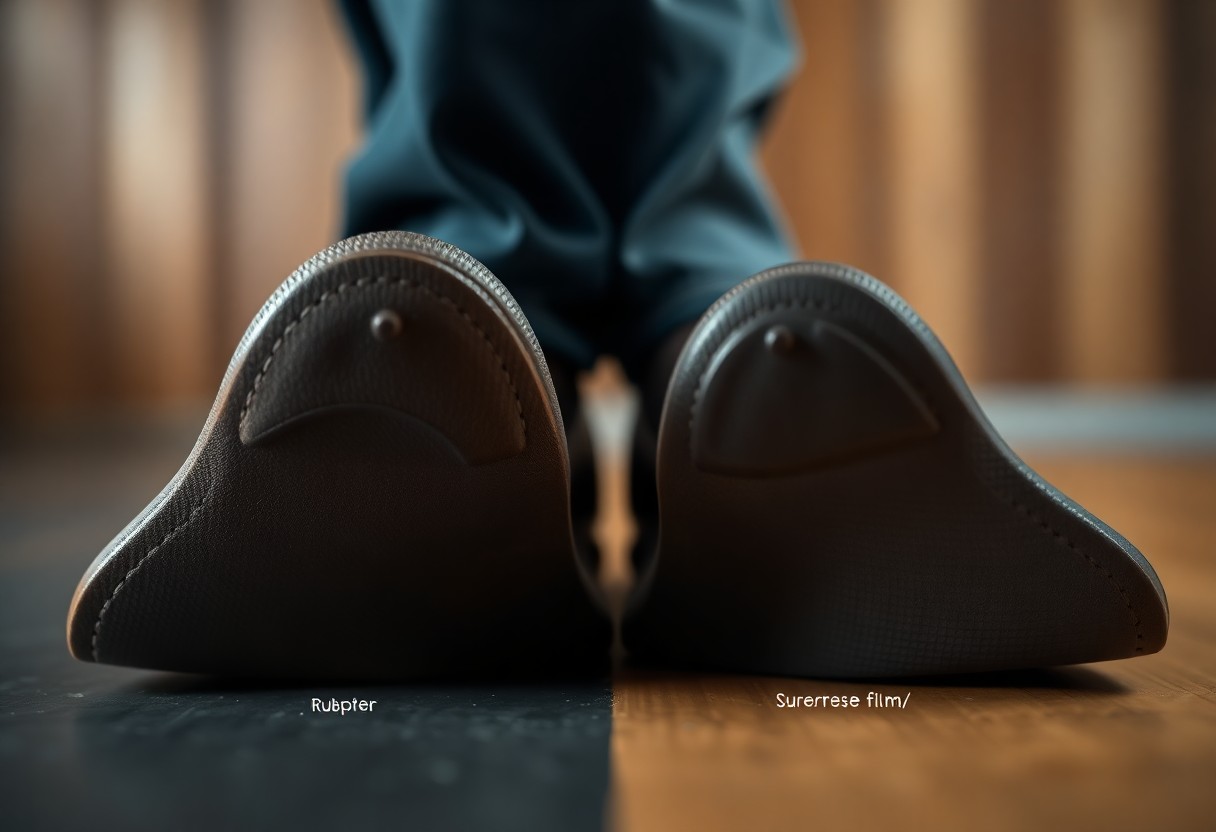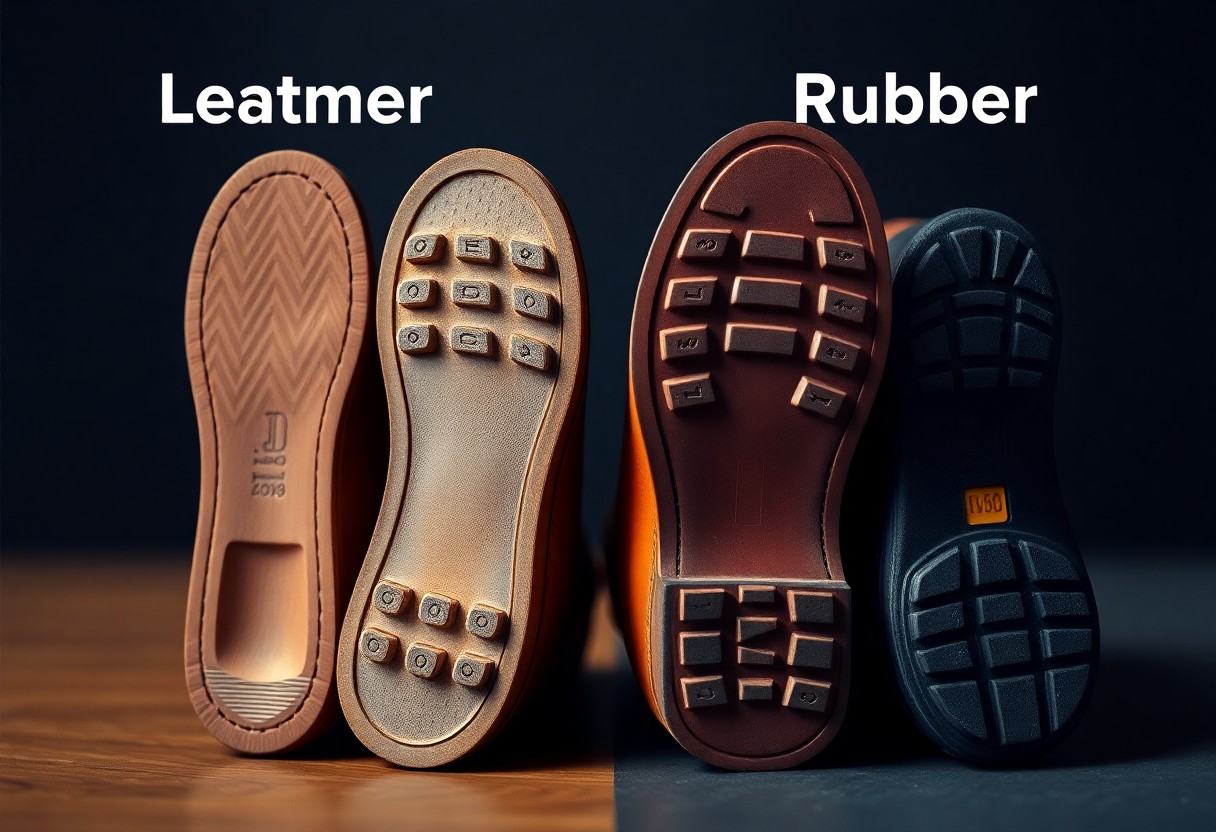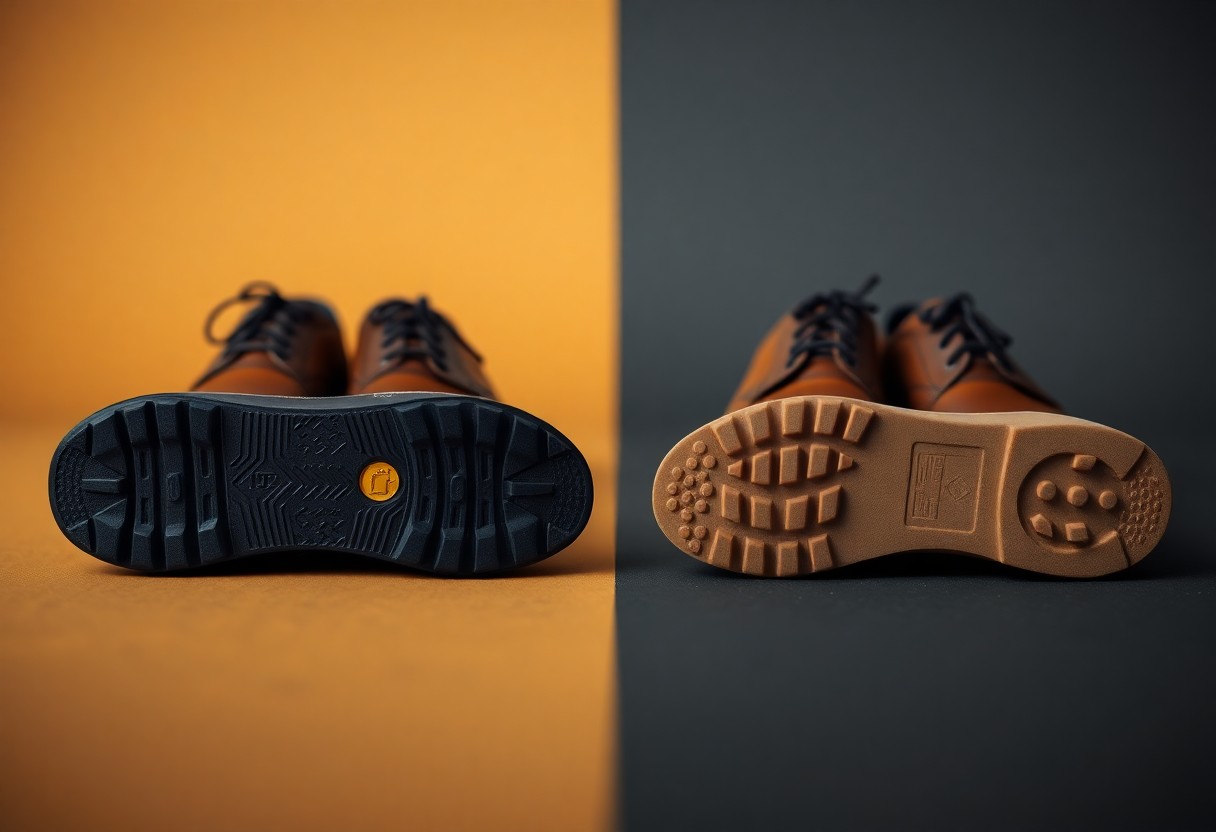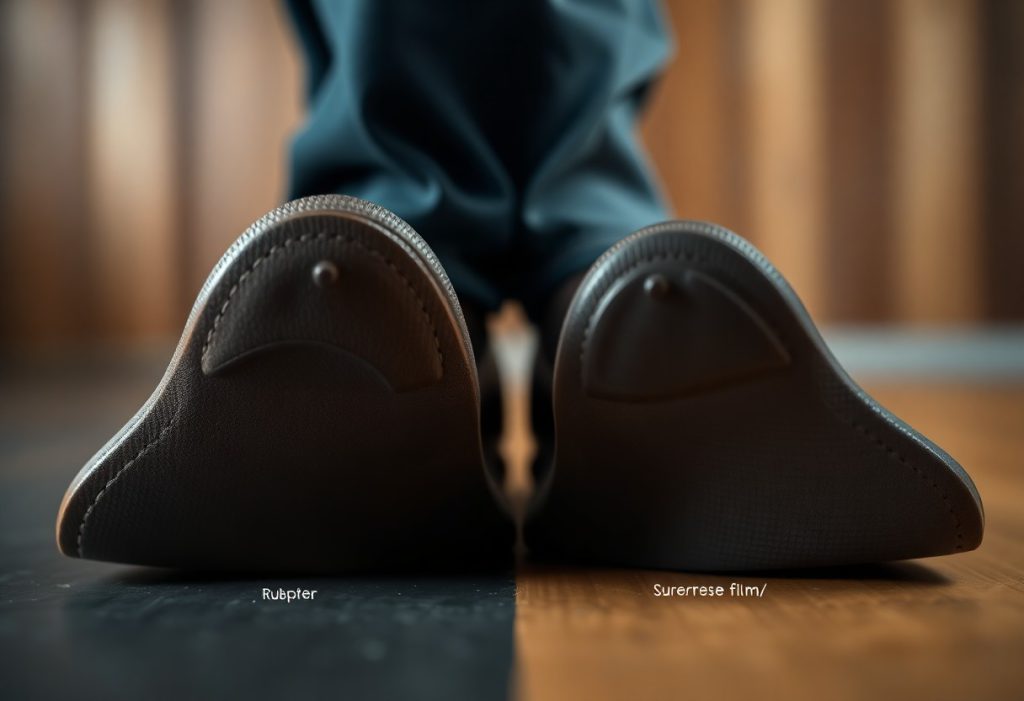When selecting new footwear, buyers often face the critical decision between leather and rubber soles. This choice significantly impacts your comfort level and overall walking experience. Leather soles are renowned for their exceptional breathability and ability to conform to the unique shape of your feet, providing a customized fit over time. In contrast, rubber soles are celebrated for their outstanding grip and water resistance. Leather soles are often favored in formal settings and develop a distinct character with age, while rubber soles deliver immediate comfort and superior traction, especially in wet or challenging conditions. This detailed guide will navigate the essential differences between these sole materials, empowering you to choose the ideal option tailored to your specific footwear needs.

Discover the Distinctive Features of Leather and Rubber Soles
To make smart footwear decisions, it's crucial to understand the various sole materials available on the market. Each material comes with unique benefits and disadvantages that can greatly affect your daily comfort, the longevity of your shoes, and your overall satisfaction. The choice between leather and rubber soles impacts not only your walking experience but also your foot health and the maintenance required for your footwear. By gaining insight into these materials, you can make a more informed decision that aligns with your lifestyle and preferences.
Unveiling the Benefits of Leather Soles for Footwear
For centuries, leather has been the go-to material for high-quality footwear. Shoes featuring leather soles are crafted from natural materials that gradually conform to the shape of your feet, ensuring a personalized fit that enhances comfort as you wear them. This material allows for excellent airflow, enabling your feet to breathe and adapt to varying temperatures throughout the day. With proper care, leather soles can last anywhere from 3 to 5 years with regular use, making them a worthwhile investment for those seeking durability and comfort.
Understanding the Key Advantages of Rubber Soles
Rubber soles are widely recognized for their remarkable water resistance and immediate flexibility. Footwear with rubber soles provides superior grip on slippery surfaces, ensuring safety and comfort right from the moment you put them on. This material retains its shape and performance across diverse weather conditions, making it an excellent choice for daily wear and active lifestyles. Rubber soles promise consistent performance in challenging environments, typically lasting around 2 to 3 years from high-quality options, which require minimal maintenance. While rubber soles excel in providing reliable traction and stability, particularly in wet conditions, they usually offer less breathability compared to their leather counterparts.
Evaluating Comfort Factors Across Footwear Sole Materials
Understanding how different sole materials impact your daily walking experience is essential for making the right footwear choice. The selection between leather and rubber soles can profoundly affect your foot health and overall comfort level. The ideal sole material should correspond to your walking habits, foot structure, and everyday activities to guarantee a satisfying fit that supports you throughout your day.
Exploring the Comfort Elements of Leather Soles
The comfort offered by leather soles can be attributed to their unique ability to mold naturally to your feet and their excellent breathability. When wearing shoes with leather soles, you benefit from several key features, including:
- Custom contouring that adjusts to your specific foot shape, enhancing overall comfort
- Natural air circulation that helps keep your feet dry and comfortable
- Cork layer cushioning that provides extra comfort for prolonged wear
- Progressive softening with continued use, ensuring a personalized fit
By understanding these unique features, you can confidently make a decision that prioritizes your long-term comfort and foot health.
Experiencing Immediate Comfort with Rubber Soles
Rubber soles excel in various weather conditions, providing instant comfort and shock-absorbing qualities. When you wear shoes with rubber soles, you will notice immediate flexibility and a lack of break-in time, making them ideal for quick, on-the-go use. The advanced technology integrated into rubber soles offers superior grip and water resistance, ensuring your safety and comfort. Although rubber does not conform to your feet like leather, it consistently provides excellent shock absorption and maintains its shape, protecting your feet from hard impacts. This makes rubber soles particularly suitable for extensive urban walking, enhancing your comfort in bustling environments.
Assessing the Durability of Different Sole Materials
When weighing the decision between leather and rubber soles, it is essential to consider their varying wear patterns and overall longevity. Your walking habits and the local weather conditions can greatly influence the lifespan of your soles. Both materials have unique advantages regarding durability, yet their effectiveness can vary widely based on usage and maintenance over time. Understanding these factors will empower you to choose the best option for your lifestyle.
Long-lasting Durability of Quality Leather Soles
With the right care and maintenance, leather soles can provide exceptional durability. When protected from excessive moisture and equipped with toe taps, leather-soled shoes can endure regular use for anywhere from 3 to 5 years. The quality of leather can be enhanced by layering; for example, a triple leather sole can outperform many other alternatives. However, it is crucial to keep them dry and properly maintained to maximize their lifespan and performance.
Robustness and Longevity of Rubber Soles
Rubber soles are known for their superior resistance to water and everyday wear. Rubber-soled shoes are built to withstand demanding conditions, typically lasting between 2 to 4 years with regular use. These soles shine on wet surfaces and require significantly less maintenance compared to leather options. However, it is important to recognize that the durability of rubber soles is heavily reliant on the quality and thickness of the rubber compound used in their construction. High-quality rubber compounds can last up to 8 years with proper care, while lower-quality versions may wear out within a few months. Ultimately, your walking style and frequency of use will determine the actual lifespan of rubber soles.
Understanding Performance in Diverse Weather Conditions
To make an informed decision about your footwear, it is vital to grasp how different sole materials perform under various weather conditions. The choice between leather and rubber soles can significantly affect your comfort and safety in diverse weather situations. Each material presents unique advantages and limitations that impact their performance in wet, dry, or icy conditions. Understanding these aspects will help you choose the most suitable footwear for your environment.
Evaluating Leather Soles in Varied Weather Conditions
Contrary to common belief, leather soles may not be the best choice for wet conditions. Water can damage leather soles, leading to a slippery surface. Leather performs best in dry weather, where it provides excellent breathability and comfort. However, in wet conditions, leather soles can absorb up to 80% of their weight in water, which can lead to accelerated wear and potential damage to your footwear.
Rubber Soles and Their Performance in Challenging Elements
Comparatively, rubber soles offer superior grip and water resistance. You can confidently wear shoes with rubber soles in rain, snow, and on slippery surfaces, benefiting from enhanced traction that ensures your safety. These soles retain their properties in temperatures ranging from -10°C to 40°C, making them more versatile for year-round use. A significant advantage of rubber soles is their exceptional water resistance and resilience in harsh conditions. They maintain their shape and grip even after prolonged moisture exposure, with non-slip characteristics that significantly enhance safety on wet surfaces, reducing your risk of accidents by up to 50% in comparison to leather soles.

Making Style Considerations for Your Footwear Selection
In the realm of style, not all sole materials are created equal. Your choice of sole can dramatically influence the overall appearance of your shoes and their suitability for various occasions. While leather soles project a refined and sophisticated aesthetic, rubber soles offer greater versatility for everyday use. Your selection should align with your personal lifestyle and the intended function of your shoes, ensuring you look and feel your best in any setting.
The Timeless Elegance of Leather Soles
For formal occasions, leather soles remain the standard choice. They are prominently featured in high-end dress shoes and formal footwear. The sleek profile, along with the natural patina that develops over time, enhances their visual appeal. Leather-soled shoes present a clean edge and maintain an elegant silhouette that epitomizes classic footwear design, making them a timeless addition to any wardrobe.
The Contemporary Adaptability of Rubber Soles
Today, approximately 70% of modern shoes are designed with rubber soles, reflecting their practicality. Your daily activities often demand footwear that can accommodate various surfaces and weather conditions. Rubber soles provide superior grip and weather resistance, making them ideal for business casual settings and everyday wear. Additionally, modern hybrid options combine both materials, offering the best of both worlds. These innovative combinations provide the elegance of leather along with the functionality of rubber, allowing you to explore dress shoes that feature thin rubber inserts or even entire rubber soles designed to mimic leather, providing a balanced solution for your footwear collection.

Analyzing the Cost Implications of Sole Materials
Despite the initial cost differences, your choice between leather and rubber soles affects both immediate expenses and long-term value. While leather soles may require more maintenance and occasional resoling, they can last 15 to 20 years with proper care. Rubber soles may seem to offer better immediate value, yet they often necessitate complete replacement once worn out, leading to potential long-term costs. Understanding these financial implications is crucial for making an informed footwear investment.
Understanding the Initial Cost Investment
Typically, leather-soled shoes command a price that is 20 to 30% higher than rubber-soled options. Investing in leather soles reflects the cost of premium materials and the skilled craftsmanship involved in their creation. This higher upfront cost often signifies superior construction methods, such as Goodyear welting, ensuring long-lasting durability and quality.
Evaluating the Long-term Value of Sole Materials
Initially, rubber soles may appear to be more cost-effective, but leather-soled shoes frequently offer better value over time. With proper maintenance and resoling, leather-soled shoes can endure for decades, while rubber soles generally require total replacement once they are worn out. Although leather soles need regular maintenance and resoling every 2 to 3 years, the associated costs are usually lower than purchasing entirely new shoes. Your investment in leather soles pays dividends due to their potential for repair and restoration, a feature that most rubber soles lack once they become damaged.
Choosing the Right Sole for Your Footwear Needs
Your decision between leather and rubber soles ultimately depends on your individual needs and lifestyle preferences. Leather soles provide superior moldability and elegant aesthetics, making them ideal for those who seek shoes that adapt to their feet while exuding a classic appeal. Conversely, rubber soles offer immediate comfort and excellent water resistance, making them perfect for individuals who frequently navigate wet conditions. Your walking habits, local climate, and personal comfort preferences will all play a crucial role in guiding your choice. Both types of soles have their place in a well-rounded footwear collection, allowing you to choose based on the primary purpose of each pair.
Your Footwear Queries Answered: Frequently Asked Questions
Q: What are the comfort differences between leather and rubber soles?
A: Leather soles gradually mold to your feet, providing a personalized fit that enhances comfort over time. They work best when combined with cork filling and proper arch support. In contrast, rubber soles offer immediate flexibility and superior shock absorption but do not conform to your foot shape. While leather typically provides better all-day comfort once broken in, rubber tends to feel comfortable initially but might lead to foot fatigue during extended wear.
Q: How do leather and rubber soles compare in durability and weather resistance?
A: Double or triple leather soles with toe taps can last many years with appropriate care. However, single leather soles may wear out more quickly and are more susceptible to water absorption. Rubber soles excel in water resistance, effectively handling rough surfaces, requiring less maintenance, and performing better in wet conditions. Ultimately, your choice should depend on your typical walking environment and frequency of use.
Q: Which type of sole should I choose based on my specific needs?
A: Choose leather soles for formal shoes and office wear, especially if your activities take place primarily indoors. They offer enhanced breathability and elegance. Alternatively, opt for rubber soles for daily commuting, frequent outdoor walking, or rainy climates. Consider your walking surface—leather performs well on smooth floors and carpets, while rubber excels on rough pavements and wet surfaces.
The Article Leather soles vs rubber soles key differences benefits and how to choose the right one appeared first on My Shoes Finder
The Article Leather Soles vs Rubber Soles: Key Differences and Benefits Was Found On https://limitsofstrategy.com



It’s fascinating how the choice of sole material can reflect not just personal style but also lifestyle needs! I’ve always found that my experience with leather soles is like a fine wine—they get better with age and really mold to the foot, making them perfect for those long evenings in more formal settings. However, my outdoor adventures definitely call for rubber soles; the grip they provide on slippery trails is unmatched.
You’ve captured the essence of shoe soles beautifully. It’s so true that the type of sole can reflect not just how we want to present ourselves, but also the various activities that shape our daily lives. Leather, with its ability to develop character over time, brings a certain charm to formal settings. The way it adapts to the foot really enhances comfort, especially when you’re out enjoying a nice dinner or attending an event where you want to look your best. It’s like stepping into something that’s uniquely yours.
This exploration of leather versus rubber soles resonates with my own footwear journey. I’ve often found that while I love the elegance and breathability of leather shoes, there are moments—like those rainy days or longer treks—when only the reliable grip of rubber can keep me grounded. It’s fascinating how footwear can embody our lifestyle choices.